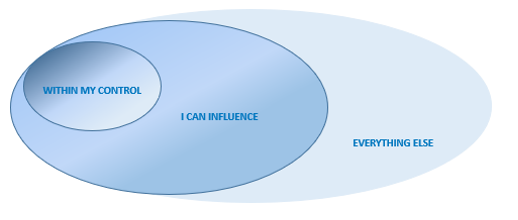Do you ever find yourself worrying or feeling stressed about things you can’t control?
Maybe it’s around global crises, war, politics, finances, or something completely different. I’d hazard a guess that if you’re honest with yourself, most people reading this article will say yes but of course that is perfectly normal. After all, worrying comes from a need to be in control, something we have found a lack of in our lives more acutely in the past few years. It can be exhausting when our minds are constantly racing with worry subsequently causing stress levels to rise and rise.
I was once told that most people spend 90% of their time worrying or feeling stressed about things that have no control over. Does that sound familiar to you? If so, you are not alone. A study underlined this by looking at how common this thinking is.
Participants were asked to write down their worries over a prolonged period and to identify which of their imagined misfortunes did not actually happen. Staggeringly 85% of participants reported that things they had worried or stressed about, never actually materialised.
Now, you may recall, I wrote about the power of thoughts in the 2022 Yearbook and so I’m not going to revisit that, however I did want to use this second article for stress awareness month to focus on another resilience and wellbeing technique that can help you manage those worries and stressors.
We refer to this as your ‘Spheres of Influence’ and just like the stress container exercise in our first article this month. If again we are honest with ourselves this little exercise can be cathartic and powerful in helping address the causes of worry and stress and help you ultimately to identify strategies to minimise them.
To get the most out of this exercise, I’d suggest you take a couple of minutes to revisit my first stress awareness month article, ‘What’s in your stress container?’.
The Technique: Spheres of Influence
- Firstly, write down all your stressors in your container, if you already did this earlier in the month, revisit it and ask yourself ‘is there anything you can now remove from the container?’ and ‘is there anything to add to the container?’ Remember to consider all those things that are causing you to feel worried, overwhelmed, stressed or anxious.
- Now, work through each worry or stressor and ask yourself, ‘do I have complete control over it, do I have partial control/influence over it, or is it completely outside of your control/influence?’.
- Add each item into the corresponding circle – within my control (can resolve them on your own without needing anyone else’s input), I can influence (can resolve part of them or influence through your own actions), everything else (nothing you could do or say that could directly impact this).
- The next step is the hardest as this is when you need to start putting this exercise into practice. Take some time to think about your spheres of influence and focus your energy on the things that are within your control and to some extent the things you can influence.
Once you have completed this process you may find that there is something sitting out to the far right where you have little control or influence but that still feels big and causes you stress and overwhelm. The times we are living in certainly mean that perhaps this may be cropping up for most of us so lets take this one step further. The example I will use here – Global Crises
Let’s be honest there is little you or I can do to ultimately change some of the major events going on in the world however we do obviously have control over ourselves.
No more so than in the last few years have we seen NFDC members and their families moving mountains to help each other during the covid pandemic and now the crisis in the Ukraine. From door step care, PPE for front line workers, food parcels, fund raising and trips to take provisions to the front line we see over and over again the impact that each of us can have in some way to help others and ultimately contribute to the things within our control.
But, for the rest of the time when we are feeling a little helpless to those things sitting outside of our influence we can take a few simple steps to turn the dial down on our stressors. For example, we can control our own media consumption thus limiting the feelings we may have of worry or stress which can trigger emotions of fear and anger, which can potentially quickly turn into sadness, guilt, and helplessness.
The opposite of helplessness is empowered; we can’t control the news, but there are things we can control which might help to make us feel more empowered:
- News consumption: Take in no more than you need, from a reputable source, ideally not before bed.
- Communication: Speak to people you trust about whatever is concerning you. It’s good to be open to different opinions but be aware of people who force their own opinions onto you.
- Emotions: From anger to fear, sadness and guilt, emotions that come from headlines can feel all consuming.
I’m not saying it’s easy, in fact it can be challenging to try and ‘let go’ of things so make sure you take that little bit of time for yourself.
The aim is to focus your attention and personal energy on what you can control and influence, after all, we only have so much energy to use!
David Price
Vector Equilibrium
www.v-eq.com
